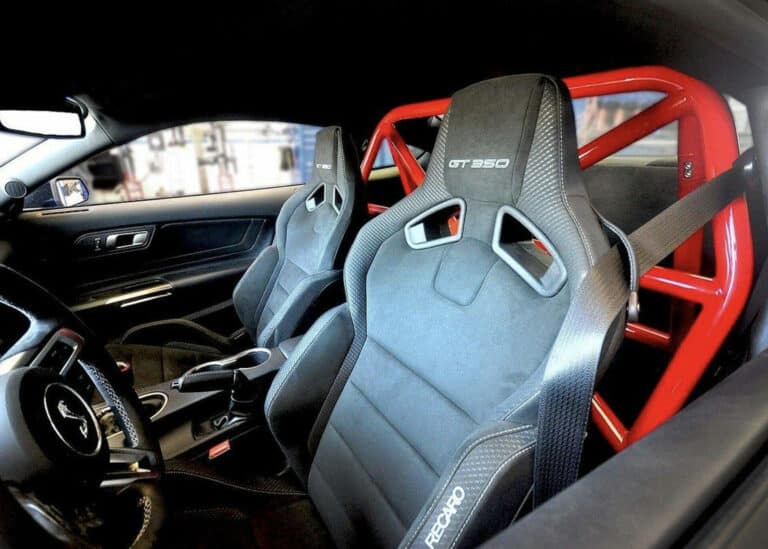
Whether your goal is to run HPDE or to be the next Mario Andretti, you need to think about your safety while on track. This article will explore the ins and outs of roll bars and roll cages.
NASA’s High Performance Driving Events (HPDE) are a very safe way to learn how to handle your car and drive the line on the race track. These events are not designed to teach you how to race, there are other schools that will teach this. All you need to run a HPDE event is your car (in good condition) and a helmet. In a convertible, you will also need to have a roll bar. This roll bar must be strong enough to withstand the forces of compression involved in supporting the full weight of the car. A factory roll bar such as those found on a Honda S2000 may fulfill this requirement, but “style bars” or “show bars” found on some other cars would not work. (If you have a question about your car, call the NASA office.) Road racing with NASA requires a full cage (defined as 6 or more mounting points).
Installing a roll bar or roll cage will bring some benefits and some liabilities. A roll bar (defined here as a protection hoop with 4 mounting points) will help protect the occupants in the case of a roll over accident. Added benefits include chassis stiffening and a place to mount your seat, harnesses, camera mount and more. Liabilities include a heavier car, hard, unforgiving metal near your head and less rear visibility. The benefits of adding a full cage includes even more chassis stiffening, even more protection (including side impact protection), road race rule compliance, and a place to mount your window net and rear view mirror. The liabilities include an even heavier car and poor egress/ingress of your car.
Roll bars and roll cages are not for everyone. Safety is a personal decision that only you can make. I tend to err on the side of safety. If something goes wrong on the track, I want to walk away from it. On the other hand, I don’t want to tear up the inside of my nice street car. So, safety has to be a compromise. Either I put the proper safety equipment in my car, or I don’t push hard on the race track. If I keep things under control on the track, I can minimize my safety concerns.
If I want to push hard on the track, I know the car was not designed to crash at the speeds we can achieve. For a school car that also runs on the street, a roll bar would be appropriate. Here we can achieve roll over protection, and all the other benefits mentioned above. In a sedan with a back seat you can even get the diagonal cross brace and shoulder harness bar made removable so that you can access the rear seat when not racing. Never put a passenger in a car with roll bar/cage bracing in front of them. This type of bracing has known to cause severe injury and even death to passengers.
If the car will be a full-out race car, the better option is for a roll cage. Here we will find that the benefits far outweigh the liabilities. The added chassis stiffening will allow for better and more predictable suspension. In turn, you will be able to run more consistently and your lap times will lower. Adding harnesses and a better seat will increase your safety and lower lap times even further.
Running faster laps puts you and your car more on the edge of adhesion. Driving more on the edge will mean that you will sometimes drive over the edge thus putting yourself more at risk to having an accident. Now you are going to be glad that you put in all that safety equipment!
The most frequently asked questions regarding roll bars and cages have to do with the different types of materials used in their fabrication. Generally, there are three different materials used: ERW, DOM and Chrome-moly. ERW stands for Electric Resistance Welded and this is a mild steel that is made from a flat sheet, rolled up into a tube and welded. DOM stands for Drawn Over Mandrel. This tubing is actually ERW tubing that has gone through an extra step to even out the imperfections and make it stronger. Chrome-moly is an alloy of steel which incorporates both Chromium and Molybdenum in the process and is stronger still. NASA’s rule book is very clear about what tubing is required for different weight cars and different classes. The rule book will tell you what is allowed and narrow down the choices.
The benefits of ERW tubing is simply that it is less expensive. The liabilities is that it is not as strong and therefore you may need to use a larger size tubing than either DOM or Chrome-moly (or ERW may not be legal at all). Using a larger tubing size means more weight and more weight mean a slower car. One must always balance cost with competitiveness. Remember, almost always there will be someone out there that can outspend you. A good racer knows where to budget their money and what will achieve the most gain for the dollar.
By Ken Myers
What is weight transfer? A car, at rest, distributes its weight over...
Some people believe that an occasional spin or crash is essential to...
Many drivers believe that the key to driving quickly is to drive...
UpshiftingUpshifting should be done smoothly. Speedshifting will shorten the gearbox life. The...
The line is the path around the track, that when driven at...
Learn the essential rules of passing during HPDE events to ensure safety...
Now that you have signed up for the HPDE, you need to...
After much prodding from my friends I finally committed to going to...